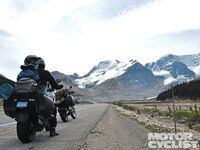You’re forgiven if you don’t think of motorcycling as a winter sport––most riders don’t. But there are others who ride all year, in all but the most severe conditions, stretching their riding season and getting more use out of their bikes. These cold-weather warriors survive (and even thrive) in low temperatures, on wet roads, and with poor visibility by preparing themselves and their bikes for winter’s worst.
Winter riding safety starts where the rubber meets the (wet) road. If your tires are already worn out after a summer of riding, they’re not going to make it through the winter. Getting new tires just as the traditional riding season draws to a close might seem odd, but your safety depends on it. Tread grooves, called sipes, channel standing water away from the contact patch and prevent hydroplaning. A balding tire with shallower sipes is more likely to rise up on the layer of water covering the road—and put you on your head.
Tire pressure takes on added importance in the wet. A motorcycle’s front tire has a rounded profile that parts the water like the hull of a boat. If its pressure is too low, the tire flattens out, resulting in a less rounded contact patch that's more likely to hydroplane.
Like tires, drive chains spend all their lives out in the open, exposed to moisture, grit, and other nasty stuff. A constant bath in water laden with road grime only accelerates wear, so lube and clean your chain and sprockets more often in the winter. The same goes for control cables and lever pivots.
The spray thrown up by cars carries small particles of dirt to your air filter more readily than dry air alone. Check your air filter more frequently in wet weather, and keep an eye on your engine oil for the whitish appearance that indicates water entering through the crankcase breather; it’s from moist air drawn into your cooling engine after shutdown. Consider more frequent oil and filter changes, too.
Rain-proofing yourself consists of picking the right foul-weather apparel for your needs. If you only ride occasionally in the rain, you can probably get by with a cheap one-piece rainsuit. Most are hard to get on and off, though, and you’ll sweat like a stevedore in them. Two-piece suits are easier to put on and give better access to your pockets. Better yet is an all-weather riding suit with a Gore-Tex lining or a similar waterproof-yet-breathable material.
As hard as motorcycles are for drivers to see in good weather, it’s worse on gloomy or rainy days. Get some riding gear in hi-viz colors or a safety vest––request one for Christmas if you’re embarrassed to buy one yourself––and check your headlights and taillights often. Seeing is as important as being seen, so if there’s a fog-free shield offered for your helmet, get one.
Wet or dry, riding in cold weather presents special challenges, the most critical of which is staying warm. Hypothermia––the fancy name for losing a dangerous amount of heat from your body––is sneaky. The symptoms, in worsening order, are shivering, loss of coordination, confusion, drowsiness, and eventually loss of consciousness.
In all but the most severe weather, preventing hypothermia means having an electric vest, and sometimes, heated gloves or grips. If you’re wondering where to start, an electric vest may negate the need for heated grips, since the vest will keep your core warm so it continues to pump hot blood to your appendages. An electric vest works just like an electric blanket. Electrical current from your bike’s battery heats up a wire mesh sewn into the vest, wrapping your torso in a big, warm hug. Most vests have a plug for a harness that connects to gloves with heating elements. Heated grips work well enough for some riders that electric gloves aren’t necessary. Whichever way you go, make sure your bike’s charging system puts out enough power to run all your heated gear without draining the battery.
Waterproof gloves or glove covers are a must, too, since cold, wet fingers have a harder time operating the controls. Finally, don’t forget your other extremities. Buy waterproof boots, treat your everyday boots with a waterproofing compound like Sno-Seal, or get a pair of slip-on Totes overboots. Dry feet are happy feet.
Quick Facts
At speed on a motorcycle in cold weather, your body can't produce heat fast enough to offset the heat lost to wind chill. A drop in your core temperature of only 3 degrees from the normal average of 98.6 is enough to initiate the early symptoms of hypothermia. Below a certain temperature, layering clothing works only temporarily, just delaying the inevitable. Heated clothing keeps on warming you.











/cloudfront-us-east-1.images.arcpublishing.com/octane/HXOUJXQWA5HBHGRO3EMJIGFMVI.jpg)

/cloudfront-us-east-1.images.arcpublishing.com/octane/3TIWWRV4JBBOLDVGRYECVVTA7Y.jpg)
/cloudfront-us-east-1.images.arcpublishing.com/octane/KIX5O23D5NAIBGFXBN3327DKZU.jpg)
/cloudfront-us-east-1.images.arcpublishing.com/octane/7GJYDUIPXRGMTMQKN6ONYOLBOU.jpg)
/cloudfront-us-east-1.images.arcpublishing.com/octane/MUQLOVLL2ZDGFH25ILABNBXKTI.jpg)
/cloudfront-us-east-1.images.arcpublishing.com/octane/TNOU5DNE2BC57MFPMGN2EIDXAM.jpg)
/cloudfront-us-east-1.images.arcpublishing.com/octane/GTCXACQGJ5HAPDTGWUQKDEH44E.jpg)
/cloudfront-us-east-1.images.arcpublishing.com/octane/S35YGSEMEZB4BLTDJTSZPF4GLA.jpg)
/cloudfront-us-east-1.images.arcpublishing.com/octane/5UOT6HPX2JFMRJAX6EH45AR4MQ.jpg)
/cloudfront-us-east-1.images.arcpublishing.com/octane/OKWOJWAKP5EP3OACCRRWPCIX2Q.jpg)
/cloudfront-us-east-1.images.arcpublishing.com/octane/2WF3SCE3NFBQXLDNJM7KMXA45E.jpg)
/cloudfront-us-east-1.images.arcpublishing.com/octane/G4MG6OUCJNBSHIS2MVVOTPX65E.jpg)
/cloudfront-us-east-1.images.arcpublishing.com/octane/IIGGWFOTOJGB7DB6DGBXCCMTDY.jpg)
/cloudfront-us-east-1.images.arcpublishing.com/octane/QSTCM6AVEZA5JJBUXNIQ3DSOF4.jpg)
/cloudfront-us-east-1.images.arcpublishing.com/octane/U4I7G625B5DMLF2DVIJDFZVV6M.jpg)
/cloudfront-us-east-1.images.arcpublishing.com/octane/B6XD6LS6IVCQPIU6HXDJSM3FHY.jpg)
/cloudfront-us-east-1.images.arcpublishing.com/octane/ICL63FEDDRDTTMINYICCEYGMDA.jpg)
/cloudfront-us-east-1.images.arcpublishing.com/octane/FCGZHQXRBZFLBAPC5SDIQLVF4I.jpg)
/cloudfront-us-east-1.images.arcpublishing.com/octane/WNOB6LDOIFFHJKPSVIWDYUGOPM.jpg)

/cloudfront-us-east-1.images.arcpublishing.com/octane/X33NU3E525ECRHXLNUJN2FTRKI.jpg)
/cloudfront-us-east-1.images.arcpublishing.com/octane/6KKT5NNL2JAVBOXMZYS5ZO76YA.jpg)
/cloudfront-us-east-1.images.arcpublishing.com/octane/J5RKG5O455GMPGQRF2OG6LRT7A.jpg)